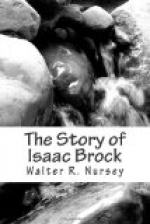A few years prior to Brock’s arrival, Governor Simcoe, with the men of the Queen’s Rangers, had cut a roadway through the dense forest between Prescott and Burlington, at the head of Lake Ontario. From Ancaster, the then western limit of the U.E. Loyalists’ settlement, this road traversed the picturesque region that surrounded the Mohawk village on the Grand River, where Joseph Brant, the famous warrior, was encamped with his Six Nation Indians. From this point it penetrated the rolling lands of the western peninsula, to the La Trenche (the Thames River), from whence Lake St. Clair and the Detroit outlet to the great lakes was reached by water. Another military road, also built by Simcoe, followed the old Indian trail through thirty-three miles of forest from York to Lake Simcoe. This shorter route to Lake Superior enabled the North-West Fur Company—established by Frobisher and McTavish, of Montreal, in 1776—to avoid canoeing up the Ottawa and its tortuous tributaries. The batteaux were brought up the St. Lawrence, breaking bulk at certain “carrying places,” then under sail up Lake Ontario to York. From here the cargoes were hauled by horses over Yonge’s military road to Lake Simcoe, thence by river and stormy Lake Huron to Fort Michilimackinac, Great Turtle Island—the Mackinaw of to-day—at the head of Lake Michigan. By this route fifty dollars was saved on every ton of freight from Ottawa to the middle north. At Mackinaw the goods were reshipped by bark canoe to the still remoter regions in the further West, where Spanish pedlars on the southern tributaries of the lower Mississippi traded with the Akamsea Indians in British goods distributed from Mackinaw.
The records of these trips through a wilderness of forest and stream, with their exhilarating hardships, had a singular fascination for Isaac Brock. It was not long before he had won, with his conquering ways and robust manhood, the allegiance of the big-hearted fur-traders in Montreal. Their wild legends of the great fur country rang in his ears, and his receptive mind was soon stored with the exploits of Radisson and Groseillers, Joliette, Marquette, and other famous pathfinders, with whose exploits a century and a half before, aided by his fluency in French, he became wonderfully familiar.
He found the evolution of the Canadian highway a subject of absorbing interest. From his Caughnawaga guides he learned how the tracks made by lynx and beaver, rabbit and wolverine, wolf and red deer—invariably the safest and firmest ways—were in turn naturally followed by Indian voyageur and fur-trader, until the blazed trail became the bridle-road for the pack-horse of the pioneer. This, as the white settler drifted in, became the winter-road; then, as civilization stifled the call of the wild, there uprose from swamp and muskeg the crude corduroy, expanding by degrees into the half-graded highway, until the turnpike and toll-bar, with its despotic keeper, exacted




